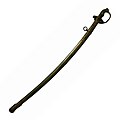| Revision as of 07:16, 20 February 2012 editLioublue09 (talk | contribs)40 editsNo edit summary← Previous edit | Revision as of 05:03, 23 April 2012 edit undoSamuraiantiqueworld (talk | contribs)Extended confirmed users3,886 edits templateNext edit → | ||
| Line 38: | Line 38: | ||
| {{Japanese |
{{Japanese (samurai) weapons, armour and equipment}} | ||
| {{Japanese WWII infantry weapons}} | {{Japanese WWII infantry weapons}} | ||
Revision as of 05:03, 23 April 2012
| This article does not cite any sources. Please help improve this article by adding citations to reliable sources. Unsourced material may be challenged and removed. Find sources: "Guntō" – news · newspapers · books · scholar · JSTOR (February 2011) (Learn how and when to remove this message) |
The shin guntō (新軍刀, "New Army Sword") was a weapon and badge of rank used by the Imperial Japanese Army between the years of 1935 and 1945. During most of that period, the swords were manufactured at the Toyokawa Naval Arsenal.

Creation of a new army sword
Until 1934 the standard sword of the Japanese military was known as the kyū guntō old military sword. The kyū guntō closely resembled European and American swords of the time, with a wraparound hand guard (also known as a D-Guard) and chrome plated scabbard.
In response to rising nationalism within the armed forces, a new style of sword was designed for the Japanese military in 1934. The shin guntō was styled after a traditional slung tachi of the Kamakura period (1185-1332). Officers' ranks were symbolized by coloured tassles tied to a loop at the end of the hilt. The corresponding colors were brown/red & gold General; brown & red field officer; brown & blue company or warrant officer; brown sergeant, sergeant major or corporal.
Type 94
The "type 94" shin guntō (九四式軍刀, kyūyon-shiki guntō) officers sword replaced the western style kyu gunto in 1934. It had a traditionally constructed hilt (tsuka) with ray skin (same) wrapped with traditional silk wrapping (ito). A cherry blossom (a symbol of the Imperial Japanese Army) theme was incorporated into the guard (tsuba), pommels (fuchi and kashira) and ornaments (menuki).
The scabbard (saya) for the Type 94 was made of metal with a wood lining to protect the blade. It was often painted brown and was suspended from two brass mounts, one of which was removable and only used when in full dress uniform. The fittings on the scabbard were also decorated with cherry blossom designs.
The blades found in "Type 94" shin guntō ranged from modern machine made blades through contemporary traditionally manufactured blade to ancestral blades dating back hundreds of years.
Type 95
The "type 95" shin guntō (九五式軍刀, Kyuugō-shiki guntō) released in 1935 was designed for use by non-commissioned officers (NCOs). It was designed to resemble an officer's shin guntō but be cheaper to mass produce. All NCO swords had machine made blades with deep fullers (bo hi) and a serial number stamped on the blade in arabic numerals. Initially the hilts (tsuka) were cast out of metal (either copper or aluminum) and painted to resemble the traditionally produced items on the officer's swords. They had brass guards similar to the officer's shin guntō.
By 1945 a simplified NCO sword was being produced. It had a simple wooden hilt with cross hatched grooves for grip. The scabbards were made from wood instead of metal and the guard and other fittings were made from iron instead of brass.
Type 98
The change to the "type 98" shin guntō (九八式軍刀, Kyuuhachi-shiki guntō) occurred in 1938 and was essentially a simplification of the "Type 94". There were only minor differences between early "Type 98" swords and the "Type 94" swords that preceded them. Most notably the second (removable) hanging point was deleted from the scabbard.
Many changes occurred to the "Type 98" between 1938 and the end of the war in 1945. Late in the war Japan's supply of metal was drying up and shin guntō were produced with painted wooden scabbards, and with cheaper or no brass ornamentation. Some of the final swords produced in the last year of the war utilized cheap copper or blackened iron fittings.
Gallery
-
 kyū guntō, a design inspired by western swords.
kyū guntō, a design inspired by western swords.
-
 Type 95 Non Commissioned Officers katana, with a cast metal painted hilt designed to look like a traditionally wrapped tsuka.
Type 95 Non Commissioned Officers katana, with a cast metal painted hilt designed to look like a traditionally wrapped tsuka.
See also
List of weapons of the Japanese Empire during World War II
External links
| Japanese weapons, armour and equipment | |||||
|---|---|---|---|---|---|
| Swords |
| ||||
| Knives and daggers | |||||
| Polearms and spears | |||||
| Practice weapons | |||||
| Armour |
| ||||
| Clothing | |||||
| Samurai accoutrements | |||||
| Chain and rope weapons | |||||
| Clubs and truncheons | |||||
| Staff weapons | |||||
| Projectile and throwing weapons | |||||
| Firearms and guns | |||||
| Improvised and other weapons | |||||
| Signal devices | |||||
| Users | |||||
| Japanese infantry weapons of World War II | |
|---|---|
| Bladed weapons | Swords: Guntō, Bayonets: Type 30, Type 2 |
| Handguns | |
| Rifles (Arisaka) | |
| Rifles (other) | |
| Submachine guns | |
| Light machine guns | |
| Heavy machine guns | |
| Hand grenades | |
| Grenade launchers and attachments | |
| Rocket launchers | |
| Flamethrowers | |
| Rifle cartridges | |
| Handgun cartridges | |